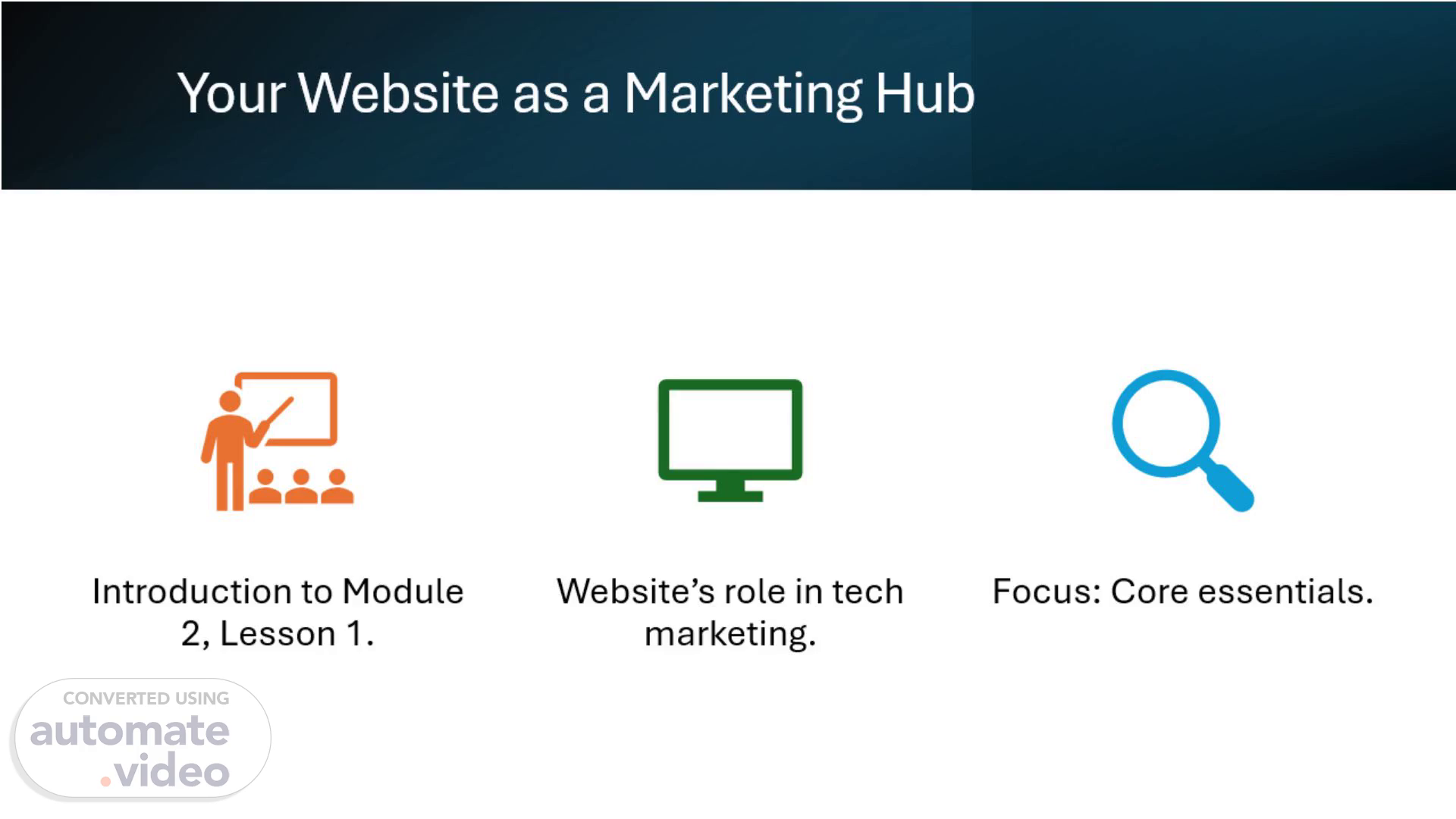Scene 1 (0s)
[Audio] Welcome back to DMT-201: Introduction to Digital Marketing for Tech Startups. I'm Robin Morris, and today we're kicking off Module 2, Lesson 1: Website Essentials for Tech Startups. You've defined your buyer and set goals—now it's time to build your online presence. Your website isn't just a digital business card; it's the heart of your marketing strategy. For tech startups, it's where trust begins and conversions happen. Let's explore the must-have elements to make it work..
Scene 2 (34s)
[Audio] First up: speed matters. A tech buyer visiting your site expects it to load fast—think under 3 seconds. Research shows that even a 1-second delay can cut conversions by 7%. Imagine an IT manager checking your solution; if the page lags, they're gone. Fast performance signals reliability, critical for startups selling technical solutions. Use tools like Google PageSpeed Insights to test and optimize—every second counts..
Scene 3 (1m 7s)
[Audio] Next, your website needs clear calls-to-action, or CTAs. Tech buyers won't hunt for what to do—they're busy. A prominent 'Request a Demo' or 'Contact Us' button guides them to the next step. Place it above the fold, meaning visible without scrolling, on every page. For a startup offering data tools, a CTA like 'See It in Action' can turn a curious visitor into a lead. Clarity here drives measurable outcomes..
Scene 4 (1m 38s)
[Audio] Mobile optimization is non-negotiable. Over 50% of web traffic comes from phones, and tech buyers—like decision-makers on the go—expect a seamless experience. A responsive design adjusts your site to any screen size, from desktop to tablet to smartphone. Without it, you risk losing half your audience. Test your site on multiple devices to ensure buttons work and text is readable. It's a basic expectation in today's market..
Scene 5 (2m 9s)
[Audio] Search engine optimization, or SEO, gets your site found. Tech buyers search for solutions using specific terms—think 'cloud integration software' or 'data security tools.' Include these keywords naturally in your titles, headers, and content. A startup in healthtech might target 'patient data management' to rank higher on Google. Good SEO brings organic traffic—buyers finding you without ads. It's a long-term win for visibility..
Scene 6 (2m 39s)
[Audio] Your action step: audit your website. Does it load fast? Are CTAs clear and clickable? Does it work on mobile? Download the Website Checklist for Startups from LearnDash—it's a quick tool to assess these essentials. Spend 15 minutes reviewing your site or a competitor's against it. This isn't just theory; it's about making your site a conversion machine. That's Lesson 1 done! Next, we'll tackle content marketing. See you in Lesson 2..
Scene 7 (3m 7s)
[Audio] Welcome back to DMT-201. I'm Robin Morris, and this is Module 2, Lesson 2: Leveraging Content Marketing. Your website's live—now it's time to fill it with value. Content marketing isn't about spamming blogs; it's a strategic way to build trust with tech buyers. By educating and engaging your audience, you position your startup as a go-to resource. Let's break down how to make content work for you..
Scene 8 (3m 35s)
[Audio] Effective content starts with your buyer's problems. What keeps them up—data breaches, slow systems? Create pieces that solve those directly. A guide like '5 Ways to Secure Your Cloud' or a case study showing '30% Faster Workflows' gives real value. Tech buyers crave insights they can use, not fluff. When you address their pain points, your content becomes a magnet for interest and trust..
Scene 9 (4m 3s)
[Audio] Choose formats that fit your audience. Blogs are great for quick, searchable explanations—like 'Why Integration Matters.' Whitepapers offer in-depth analysis, perfect for buyers researching big decisions—think 'The Future of Data Automation.' Videos demonstrate your product in action, appealing to visual learners. A startup might use all three: blog for traffic, whitepaper for leads, video for demos. Variety keeps your content versatile..
Scene 10 (4m 38s)
[Audio] Content isn't just for show—it drives results. Pair it with SEO by using keywords your buyers search, like 'best project management tools.' Add calls-to-action—'Download the Full Report' or 'Try It Free'—to turn readers into leads. A well-placed CTA in a blog can nudge a visitor to engage further. For tech startups, content is a pipeline from awareness to action, fueling both traffic and conversions..
Scene 11 (5m 9s)
[Audio] Consistency and quality are your content's backbone. Posting regularly—say, biweekly blogs—shows reliability, keeping you top-of-mind for buyers. But quality matters more than churning out filler; one strong piece beats five weak ones. A startup might plan a monthly whitepaper and weekly tips, balancing depth and frequency. This cadence builds authority over time, critical for tech audiences who value expertise..
Scene 12 (5m 41s)
[Audio] Your turn: brainstorm a content idea. What's a problem your buyer faces—like slow reporting—and how can you solve it? Download the Content Idea Starter Kit from LearnDash to spark ideas in 10 minutes. Try 'How Automation Cuts Reporting Time by 25%' as a blog or video. This sets you up for success. That's Lesson 2 wrapped! In Module 3, we'll hit social media and ads. See you there with more growth tactics..
